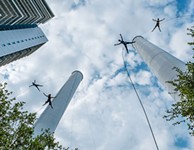The Trash Project
In turning sanitation workers into dancers and machines into giant birds, this work thrilled
Reviewed by Jonelle Seitz, Fri., Sept. 18, 2009
The Trash Project
Austin Studios Tarmac
Sept. 12
Packed like sardines on bleachers and overflowing onto towels placed on the wet pavement, a be-drizzled audience looked out over the tarmac at Austin Studios as the piano in Graham Reynolds' score began trilling. The many little boys in the audience fell silent: The trucks were coming! Sixteen of them – side-loaders, rear-loaders, recycling trucks, yard trimmings collectors, street sweepers, bucket trucks, a dead-animal collection truck, and a crane with a big claw at the end – emerged from a well-hidden spot stage right with headlights beaming and safety lights flashing, circling the tarmac to cheers and applause.
The Trash Project, the latest brainchild of Forklift Danceworks choreographer/director Allison Orr, showcased the equipment and organization of Austin's Solid Waste Services, as well as its skilled, hardworking crew of 400. Trash collection isn't generally a career to which lots of people aspire, but why not? Based on interview clips included in the performance and the program biographies of the performers, employees of SWS take pride in their work, seem enlightened about its importance, and enjoy schedules that leave a bit of time for things such as being a blues musician, coaching Little League, and raising five kids. And, anyway, trash is no longer just trash – it's compost; it's recyclable; it's reducible; it's cleanable. The old idea of an invisible force that gets rid of our trash every week before it starts to stink is obsolete. Now, trash is everybody's problem.
The performance included little actual trash, but that didn't diminish the thrill. With the exception of some unexpected showcasing of talents among the employees, including a harmonica solo by Orange Jefferson and a rap by Ivory Jackson Jr., the most interesting and well-rehearsed sections of the project were performed with machinery. A duet of rear-loaders and their crews performed a number in which they raced around to upturn 90-gallon garbage carts. The movements of the rear-loaders were the least dramatic of all the truck tricks, but through the repetition of the simple lock-up-down routine, I began to see small differences in the way the workers did things: One kicked a cart back into place; another pushed. One flipped a cart's lid closed as it descended; another waited until the cart was grounded. Anyone who has done a repetitive physical job can probably relate to the feeling of getting in the groove of routine, and Orr, perfectly legitimately, sees this as dance, or at least as having the beginnings of dance.
The side-loading trucks were the stars of a clever, beat-happy quartet in which the automated arms and claws grabbed garbage carts and swung them up high in syncopation. The combination of music and novelty, plus the good humor of the operators, resulted in an alchemy such that you could almost sense the trucks' cool intelligence. But machine-as-extension-of-human was most apparent in a solo for a crane and its operator, Don Anderson. To Reynolds' sweeping, poignant strings (and Stephen Pruitt's quiet lighting), Anderson – I swear I'm not making this up – turned this hunk of metal and wires into something with qualities you might imagine shared by a prehistoric bird. As the joint straightened with its giant claw suspended from the end, the broad arc of musclelike tension was profound, and the slight waver of the claw belied something raw yet affected and avian. The claw stretched fully open, soaring like legs in a grand jeté, and closed, edges just barely touching to make a circle. Then the entire thing spun, fast and swooping, before the arm slowly folded back against itself to gently rest the claw on the truck's bed. Now that's something you don't see every day.











